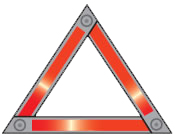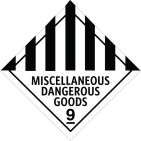Unfortunately, crashes happen on our roads. As a responsible rider, you need to know the signs that tell you a crash scene is ahead and what your responsibilities are if you’re involved in or come across a crash.
At a crash site, the police may use signs, flashing lights and flares to warn approaching road users. When coming up to a crash site, slow down and ride carefully. The road may be blocked and there could be injured people lying on it.
Police put these signs near a crash site. They mean you must ride at 20km/h or less until you pass the crash site. Watch out for emergency workers and injured people.


This is a reflective warning triangle. It means there’s a breakdown or crash ahead. Anyone can put a warning triangle on the side of the road to warn other road users.

If you’re involved in a crash while riding, and you aren’t badly injured, the first thing you must do is stop and check to see if anyone is hurt and help them.
If someone is hurt, you must tell a police officer as soon as possible and no later than 24 hours after the crash.
If no one is hurt, you must give your name, address and plate number as soon as possible but no later than 48 hours after the crash to:
If you can’t find these people, you must tell a police officer as soon as possible and no later than 60 hours after the crash.
If your vehicle is insured, tell your insurance company as soon as possible after the crash.
If it isn’t your vehicle and you’re asked, you must also give the name and address of the owner of the vehicle you’re driving.
If you’re first on the scene of a crash, your actions could help save the lives of the people involved and make it safer for other people coming across the crash scene.
Here are some things you can do to help make the crash scene safer:
Ideally, you should enrol in a recognised first aid course to learn techniques such as primary assessments and cardiopulmonary resuscitation (CPR). This will make you more confident and capable of using first aid if you have to.
If a victim has spinal injuries, moving them may make their injuries worse – never move a crash victim unless it’s absolutely necessary. You should only move someone before medical help if:
If the crash victim is a motorcyclist, never remove their helmet.
If the patient is bleeding badly, you should try to stop or reduce the bleeding. Put on gloves for protection if possible, and apply direct pressure to the wound, preferably with thick, folded fabric, such as a towel or an item of clothing.
Be very careful at a crash involving a vehicle carrying dangerous goods. Never make a rescue attempt unless you’re sure you won’t come into contact with dangerous substances. Don’t get close unless you know it’s safe.
The 4 main things to take note of when describing a dangerous goods sign to emergency services are the:

